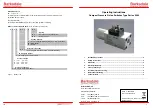
If you specify the TFTP server name in the DHCP server-lease database, you must also configure the TFTP
server name-to-IP-address mapping in the DNS-server database.
If the TFTP server to be used is on a different LAN from the device, or if it is to be accessed by the device
through the broadcast address (which occurs if the DHCP server response does not contain all the required
information described previously), a relay must be configured to forward the TFTP packets to the TFTP server.
The preferred solution is to configure the DHCP server with all the required information.
Purpose of the DNS Server
The DHCP server uses the DNS server to resolve the TFTP server name to an IP address. You must configure
the TFTP server name-to-IP address map on the DNS server. The TFTP server contains the configuration
files for the device.
You can configure the IP addresses of the DNS servers in the lease database of the DHCP server from where
the DHCP replies will retrieve them. You can enter up to two DNS server IP addresses in the lease database.
The DNS server can be on the same LAN or on a different LAN from the device. If it is on a different LAN,
the device must be able to access it through a router.
How to Obtain Configuration Files
Depending on the availability of the IP address and the configuration filename in the DHCP reserved lease,
the device obtains its configuration information in these ways:
• The IP address and the configuration filename is reserved for the device and provided in the DHCP reply
(one-file read method).
The device receives its IP address, subnet mask, TFTP server address, and the configuration filename
from the DHCP server. The device sends a unicast message to the TFTP server to retrieve the named
configuration file from the base directory of the server and upon receipt, it completes its boot up process.
• The IP address and the configuration filename is reserved for the device, but the TFTP server address is
not provided in the DHCP reply (one-file read method).
The device receives its IP address, subnet mask, and the configuration filename from the DHCP server.
The device sends a broadcast message to a TFTP server to retrieve the named configuration file from
the base directory of the server, and upon receipt, it completes its boot-up process.
• Only the IP address is reserved for the device and provided in the DHCP reply. The configuration filename
is not provided (two-file read method).
The device receives its IP address, subnet mask, and the TFTP server address from the DHCP server.
The device sends a unicast message to the TFTP server to retrieve the network-confg or cisconet.cfg
default configuration file. (If the network-confg file cannot be read, the device reads the cisconet.cfg
file.)
The default configuration file contains the hostnames-to-IP-address mapping for the device. The device
fills its host table with the information in the file and obtains its hostname. If the hostname is not found
in the file, the device uses the hostname in the DHCP reply. If the hostname is not specified in the DHCP
reply, the device uses the default
Switch
as its hostname.
After obtaining its hostname from the default configuration file or the DHCP reply, the device reads the
configuration file that has the same name as its hostname (
hostname
-confg or
hostname
.cfg, depending
on whether network-confg or cisconet.cfg was read earlier) from the TFTP server. If the cisconet.cfg file
is read, the filename of the host is truncated to eight characters.
System Management Configuration Guide, Cisco IOS XE Gibraltar 16.10.x (Catalyst 9200 Switches)
58
Performing Device Setup Configuration
Purpose of the DNS Server
















































